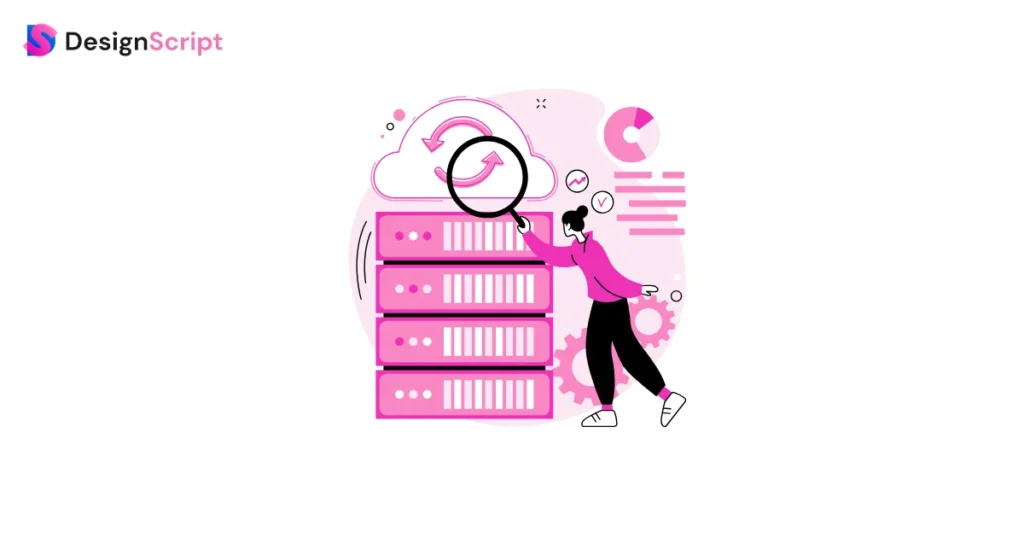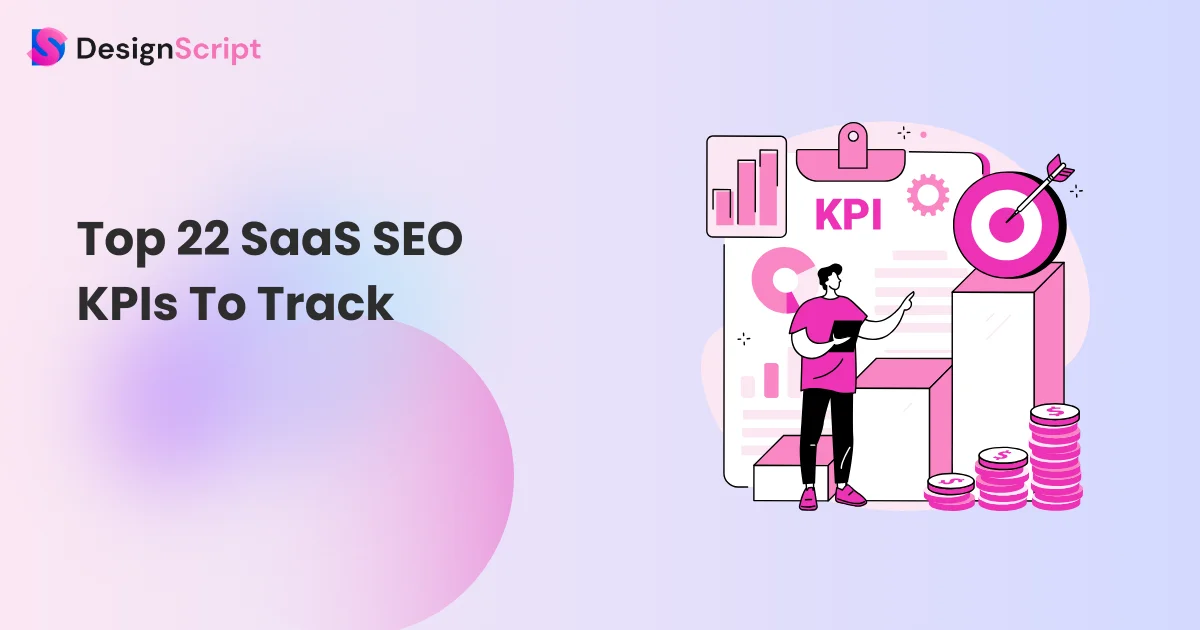Top 22 SaaS SEO KPIs To Track
Do you know that 3/4th of customers perform an internet search before purchasing a product or service? It may sound overwhelming but it is true. If you are a SaaS business owner and don’t know how to handle this, you’re not alone. In the competitive world of SaaS, ranking high on search engine results pages is a must for organic traffic and conversions. But how do you measure your SEO success?
Fear not! Here are the top 22 SaaS SEO KPIs you should track to optimize your strategy and stay ahead of the curve!
This blog post dives deep into the key performance indicators (KPIs) that matter most for SaaS companies. We’ll cover everything from website traffic and conversions to backlinks and ROI, providing a comprehensive framework to track your SEO progress and make data-driven decisions.
So, whether you’re a seasoned SEO pro or just starting, this guide will help you with the essential metrics to measure your SaaS SEO success.
Let’s dive in!
Table of Content
- What Makes SaaS SEO Different?
- Why is SEO Important for SaaS Companies?
- Important SaaS SEO KPIs to monitor
- 1. Keyword rankings
- 2. Organic traffic
- 3. MRR (Monthly Recurring Revenue)
- 4. Non-branded vs branded searches
- 5. Organic impressions
- 6. Organic CTR
- 7. Bounce rate
- 8. Average time on site
- 9. Site speed
- 10. Crawl errors
- 11. Total backlinks
- 12. Referring domains
- 13. Search visibility
- 14. Conversions from organic traffic
- 15. SEO ROI
- 16. Number of indexed pages
- 17. Website Health Score
- 18. Domain Rating
- 19. CTR from organic search
- 20. Core Web Vitals
- 21. Engagement metrics
- 22. ACV & CLTV
- Identify Your Top 3 SaaS SEO KPIs Today And Start Tracking!
- FAQs
What Makes SaaS SEO Different?

SaaS SEO differs from traditional SEO in a few key ways. Unlike physical products, SaaS offerings can be complex and intangible, making it more challenging for search engines to grab their value. Because of this, SaaS SEO strongly emphasizes content that educates potential customers and showcases the problem-solving capabilities of your software.
Another key differentiator is the focus on the customer journey. SaaS sales cycles tend to be longer, so SaaS SEO strategies must target users at various stages of consideration. This means creating content that addresses their initial awareness of the problem, guides them through the features and benefits of your solution, and ultimately convinces them to choose your services over competitors.
Finally, retention is just as crucial as acquisition for SaaS businesses. Unlike a one-time purchase, success depends on keeping users engaged and subscribed over time. As a result, SaaS SEO often incorporates content that helps users get the most out of your product, fostering long-term customer satisfaction and loyalty.
Why is SEO Important for SaaS Companies?

SaaS companies need a strong online presence to thrive in today’s digital world, where competition is fierce. This is where SEO (Search Engine Optimization) comes in. It’s like putting up a giant neon sign for your software. Still, instead of a physical street corner, it’s on the search engine results pages that potential customers frequent. Here’s how SEO supercharges your SaaS game:
1. Boosts visibility
SEO helps your website to rank higher for relevant keywords that people use to find solutions like yours. The higher you rank, the more likely people are to see your website, putting your software in front of a wider audience.
2. Attracts high-quality traffic
SEO isn’t just about getting noticed; it’s about attracting the right attention. By focusing on keywords related to the problems your software solves, you’re more likely to attract leads who are genuinely interested in what you offer.
3. Provides long-term results
Unlike some marketing tactics, SEO delivers long-term benefits. Once you’ve optimized your website and content, you’ll continue to grow the rewards of organic traffic for months and even years. This provides a steady stream of customers without needing a constant influx of cash for advertising.
In short, SEO is an investment that pays off. It helps you get seen by the right people, attract those most likely to convert, and fuel long-term growth for your SaaS business.
Important SaaS SEO KPIs to monitor

For SaaS companies, organic search engine optimization is a powerful tool for potential customers and drives growth. But with so many metrics available, it’s crucial to focus on the KPIs that truly matter. Here are essential SaaS SEO KPIs you should be monitoring to ensure your SEO efforts are paying off:
1. Keyword rankings
This is the foundation of any SEO strategy. Keyword rankings are a fundamental KPI for monitoring the success of your SaaS SEO strategy. They act as a report card, indicating your website is classified in search engine results pages for the most relevant keywords to your potential audience and by tracking your keyword rankings, you can gain insights into the effectiveness of your SEO efforts. Tracking your website’s ranking for relevant keywords tells you how well search engines see your content as valuable for user queries. Higher rankings for targeted keywords generally translate to increased organic traffic, so monitoring your progress is vital and tools like Google Search Console can help you identify your current ranking positions and track their movement over time.
2. Organic traffic
Organic traffic refers to the explorer who lands on your website from the search engine results page. As your SEO efforts improve and your keyword rankings climb, you should see a natural increase in organic traffic. This rising tide of visitors presents a valuable opportunity to convert them into paying customers. By monitoring organic traffic alongside other conversion metrics with tracking the success of your SEO strategy in attracting potential customers.
3. MRR (Monthly Recurring Revenue)
The ultimate goal of any SaaS business is to generate revenue. While not a direct SEO metric, MRR provides a crucial insight into the financial impact of your SEO efforts. You can demonstrate your SEO strategy’s return on investment (ROI) by tracking how much revenue is generated from organic traffic sources. Tools like marketing automation platforms can assist you attribute revenue to specific traffic sources, allowing you to see the tangible impact of SEO on your bottom line.
4. Non-branded vs branded searches
This metric reveals the balance between people searching for your company by name (branded) and those finding you through general keyword searches (non-branded). A healthy SEO strategy should see growth in both areas. Increasing branded searches indicates rising brand awareness. In contrast, growth in non-branded searches suggests your SEO efforts effectively attract new audiences through relevant keywords.
5. Organic impressions

Organic impressions represent the number of times your website appeared in search results for a given period, regardless of whether users clicked on it. This metric offers valuable insights into your website’s visibility in search engine results pages (SERPs). While not a direct measure of traffic, rising impressions indicate your SEO efforts are making your website more discoverable in search results, potentially leading to increased organic traffic over time.
6. Organic CTR
Organic click-through rate (CTR) is a crucial KPI for monitoring the effectiveness of your SaaS SEO strategy. It tells you the percentage of people who see your website listing in search results (impressions) and then decide to click on your link. A high CTR indicates that your title tags, meta descriptions, and overall search result snippets are compelling and accurately reflect the content users seek. This metric reveals how enticing your website appears in search results. A high organic CTR indicates that users find your titles and descriptions compelling and click to learn more about your SaaS offering. Conversely, a low CTR suggests optimizing your meta descriptions and titles to reflect search intent better and entice users to visit your site.
7. Bounce rate
This KPI measures the percentage of explorers who quit your website after viewing just one page and the high bounce rate can signal that your landing pages aren’t effectively addressing user needs or that your content isn’t relevant to the keywords users searched for. Analyzing bounce rates by keyword and page can help identify areas for improvement.
8. Average time on site
Average time on site is a crucial KPI (Key Performance Indicator) to monitor for SaaS (Software as a Service) companies focused on SEO (Search Engine Optimization). This metric shows how long users typically spend engaged with your website content. A higher average time on site suggests your content is informative and keeps users interested. It can also indicate a well-structured website that guides users towards valuable resources. It gauges how long visitors spend engaged with your website after arriving through organic search. This metric provides valuable insights into user interest, content effectiveness, and overall SEO success.
9. Site speed
Fast loading times are essential for user experience and SEO success. Search engines categorize websites that load quickly, so a slow website can negatively impact your website rankings. Tools like Google PageSpeed Insights can help you identify areas for development and optimize your website for speed.
10. Crawl errors

Search engines use crawlers to navigate and index your website. Crawl errors occur when these crawlers encounter issues accessing or understanding your website’s content. Fixing crawl errors ensures that search engines can properly index your website and show it in relevant search results. By monitoring and addressing these KPIs, you can attain valuable insights into how users interact with your website and how well search engines perceive it. This data can then be used to refine your SEO strategy, improve user experience, and drive qualified leads for your SaaS business.
11. Total backlinks
This refers to the total number of backlinks (links from other websites) referring to your website and the number of unique domains those links come from (referring domains). Backlinks are a strong SEO signal, indicating that other sites notice your content is valuable and trustworthy. A healthy backlink profile with a good mix of high-authority referring domains can boost your search rankings and organic traffic.
12. Referring domains
This metric indicates the number of unique websites linking to your SaaS website. Higher numbers suggest stronger brand authority and organic traffic potential. Search engines consider backlinks a sign of trustworthiness and relevance, so having high-quality websites linking to you can improve your search ranking.
13. Search visibility
This KPI measures how prominent your website is in SERPs for your select keywords. Tools like Google Search Console can track your average ranking position for these keywords. Higher rankings generally translate to more organic traffic. Hence, monitoring search visibility helps you understand how well your SEO strategy targets the right keywords.
14. Conversions from organic traffic
This metric dives deeper than just website traffic. It tracks how many visitors from organic searches convert into paying customers or leads. Analyzing conversions from organic traffic helps you identify which keywords and landing pages are most effective at driving valuable actions and can then focus your SEO efforts on maximizing those pages and content for better results.
15. SEO ROI

This KPI measures the financial benefit you’re getting from your SEO efforts. It divides the revenue generated from organic traffic by the cost of your SEO investments. Tracking SEO ROI helps you understand the financial impact of your SEO strategy. It allows you to make data-driven decisions about resource allocation.
16. Number of indexed pages
This metric shows how many of your website’s pages are discoverable by search engines. Comprehensive indexing ensures that users can find your valuable content. If important pages aren’t indexed, they can’t rank in search results, so monitoring this metric helps ensure you’re getting the most out of your SEO efforts.
17. Website Health Score
Several SEO tools provide website health scores, which offer a general overview of your website’s technical SEO performance. Monitoring this score helps identify and address technical issues affecting search engine visibility. Technical SEO refers to the behind-the-scenes factors that affect search engine crawling and indexing so that search engines can more easily discover a healthy website.
18. Domain Rating
This metric was developed by Ahrefs, a popular SEO tool that estimates the overall strength of a website’s backlink profile. A higher DR suggests a website has more backlinks from high-authority websites, potentially leading to better search rankings. Search engines see Backlinks from high-quality websites as more valuable, so a strong backlink profile can significantly improve your SEO.
19. CTR from organic search
One of the key performance indicators you should monitor for your SaaS business’s SEO is organic click-through rate. This metric tells you what probability of people who see your website listing in search results click on it. A high CTR means your search result snippets are compelling and effectively pique user interest. By keeping an eye on your organic CTR, you can identify areas for improvement. For instance, if a particular keyword has a low CTR, it might be a sign that your title tag and meta description aren’t clear or don’t align with search intent.
20. Core Web Vitals

This set of metrics from Google measures how fast your web pages load, how responsive they are to user interaction, and how visually stable they are. Good Core Web Vitals enhance user experience and contribute to better search engine rankings. These are a set of Google metrics that measure how fast your website loads, reacts to user interaction and renders content visually. Since user experience is a big ranking factor, keeping an eye on CWV is crucial. Tools like Google Search Console can help you to track Largest Contentful Paint (LCP), First Input Delay (FID), and Cumulative Layout Shift (CLS). Optimizing these aspects can lead to better user engagement and higher search rankings.
21. Engagement metrics
These metrics delve deeper into how users interact with your website after landing from organic search. They include average time on site, bounce rate, and pages per session. A high average time on site and low bounce rate suggests users find your content valuable and engaging. Pages per session indicate how deeply users explore your website, potentially seeking solutions your SaaS offers.
22. ACV & CLTV
While not directly SEO metrics, ACV and CLTV provide precious insights into the revenue generated from organic traffic. ACV is the average revenue a customer brings in during a specific period. CLTV is the total revenue a customer is expected to generate throughout their bond with your company. By analyzing ACV and CLTV alongside your SEO efforts, you can understand how organic search contributes to your overall business goals.
Identify Your Top 3 SaaS SEO KPIs Today And Start Tracking!
In the changing world of SEO, staying ahead of the curve can feel overwhelming. However, by focusing on the right KPIs, you can ensure your SaaS SEO strategy is on the right track. This comprehensive list lets you measure everything from website traffic and conversions to backlinks and ROI.
Stay aware of the sheer number of metrics. Start by identifying the KPIs most relevant to your business goals. For example, if brand awareness is a top priority, focus on metrics like branded search traffic and social media engagement. Once you have a prioritized list, set up tracking for those KPIs and consistently monitor your progress. By making data-driven decisions and optimizing your SEO strategy, you can unlock the potential of organic search and fuel long-term growth for your SaaS company.
So, take action today! Identify your essential KPIs and start tracking your progress. Data is power – use it to refine your SEO strategy and watch your SaaS business thrive. You can thank us later!
FAQs
Track metrics like organic traffic, leads generated, and conversions to see how your SEO efforts are driving valuable users to your site.
Focus on creating informative content that educates potential customers, optimize your website for search engines, and build backlinks to establish authority.
SaaS SEO targets user intent throughout the buying journey, with content that addresses their problems and showcases how your software solves them. It prioritizes conversions alongside attracting visitors.

